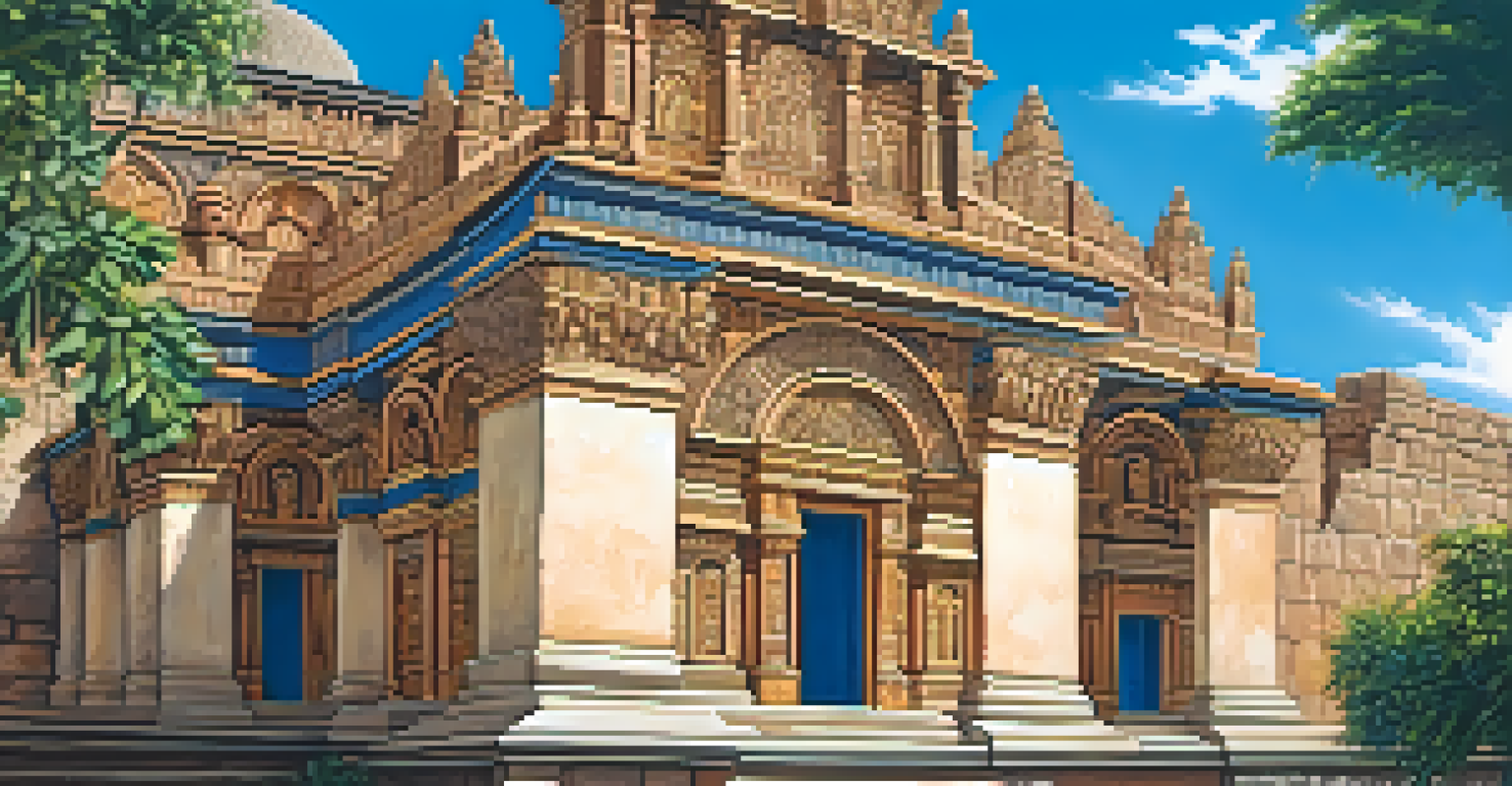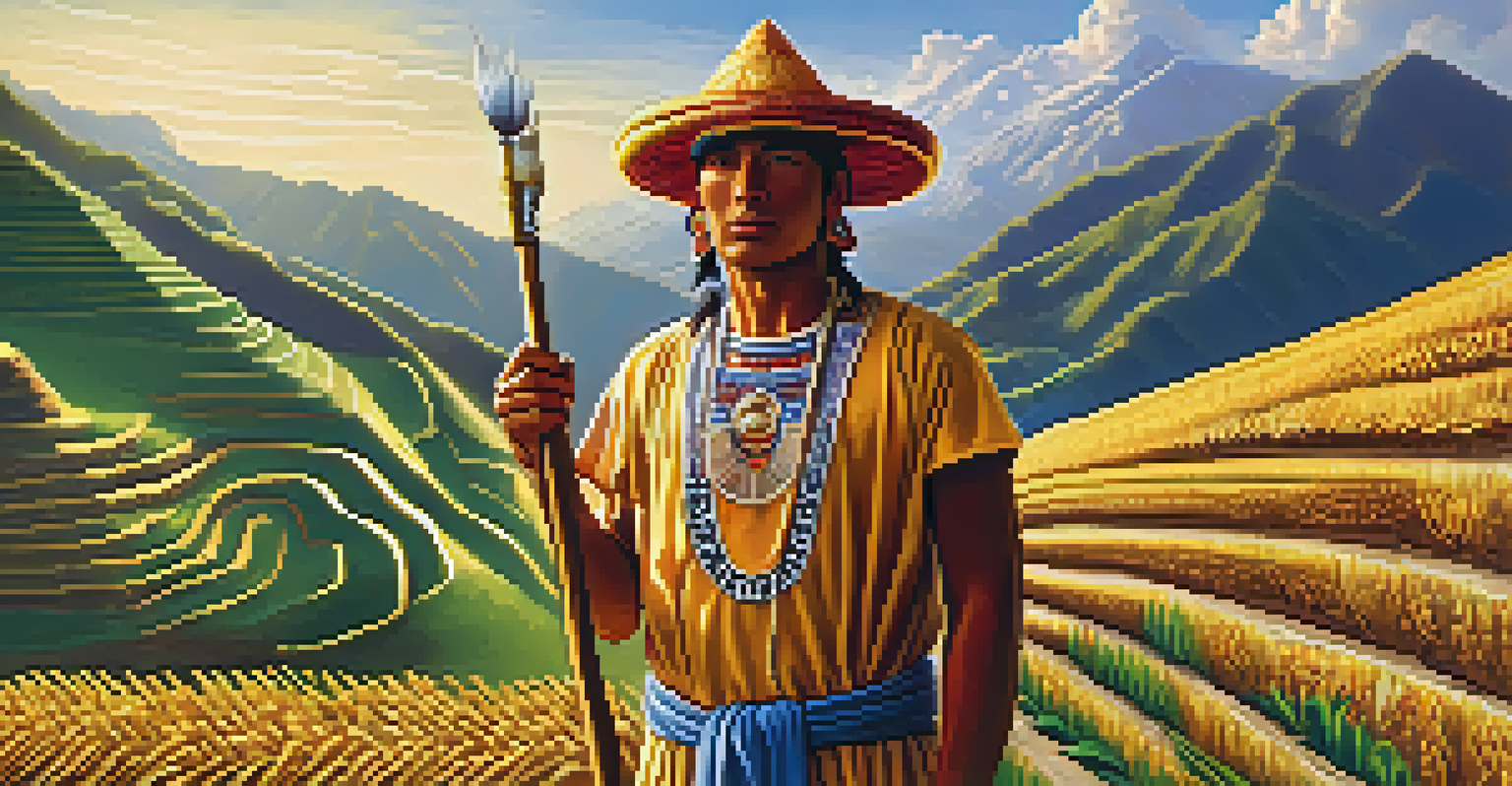The Legend of the Inca: Stories of the Ancient Empire

The Rise of the Inca Empire: A Brief Overview
The Inca Empire, which thrived from the early 15th century until the Spanish conquest in the 16th century, was one of the largest empires in pre-Columbian America. Centered in modern-day Peru, it expanded rapidly, connecting diverse cultures across the Andes mountains. The Incas are renowned for their sophisticated agricultural systems, impressive architectural feats like Machu Picchu, and a vast network of roads that facilitated communication and trade.
The Inca civilization was a marvel of human ingenuity, with its sophisticated agricultural practices and monumental architecture.
At the heart of the Inca civilization was a complex social structure that emphasized community and cooperation. The Sapa Inca, or emperor, was considered a divine figure, believed to be the descendant of the sun god. This belief system reinforced loyalty among the people and helped solidify the empire's power across vast territories.
The Inca's innovative practices, such as terrace farming and freeze-drying food, were essential for sustaining their large population in the challenging Andean environment. Their achievements in engineering and agriculture laid the groundwork for a remarkable civilization that has fascinated historians and travelers alike.
The Legends of Viracocha: Creator God of the Incas
Viracocha, the Inca creator god, is central to many legends and stories within the culture. According to myth, he emerged from Lake Titicaca and created the sun, moon, and stars, as well as the first humans. These tales not only illustrate the Incas' reverence for nature but also their understanding of creation and existence.

One popular story recounts how Viracocha traveled across the land, teaching people how to cultivate crops and live harmoniously. His teachings emphasized the importance of community and respect for the earth, showcasing the Incas' agricultural prowess. This connection to the land is evident in Inca practices and rituals that honor both their gods and the environment.
Inca Empire's Agricultural Innovations
The Incas developed advanced agricultural practices, such as terrace farming and freeze-drying, to sustain their large population in the challenging Andean environment.
Viracocha's influence extended beyond mythology; he became a symbol of hope and resilience. During tough times, the Incas would pray to him for guidance, reflecting their need for divine support in their daily lives. These legends of Viracocha continue to resonate, reminding us of the powerful role that spirituality played in Inca society.
The Mummy of Juanita: A Tale from the Andes
In 1995, the well-preserved mummy of a young girl named Juanita was discovered at the top of Mount Ampato in Peru, shedding light on Inca rituals. Archaeologists believe that Juanita, who was likely sacrificed in a religious ceremony, represents the Inca's deep spiritual beliefs. This discovery sparked interest in the practices surrounding human sacrifices, which were thought to appease the gods.
Inca myths and legends embody the profound connection the civilization had with nature and their gods.
The story of Juanita illustrates the significant role of sacrifice in the Inca culture. It is believed that children were often chosen for these rituals due to their purity and connection to the divine. The meticulous care taken to preserve her body reflects the Incas' respect for the afterlife and their belief in an eternal spirit.
Juanita’s story serves as a poignant reminder of the lengths to which the Incas would go to ensure harmony with their gods. The preservation of her remains has not only provided insight into their religious practices but also highlights the complex relationship the Incas had with life, death, and the world beyond.
Inti: The Sun God and His Importance
Inti, the sun god, was one of the most revered deities in the Inca pantheon. The Incas believed that Inti was the source of light and warmth, vital for their agricultural success. Festivals such as Inti Raymi, celebrated during the winter solstice, showcased the community's gratitude and devotion to this powerful god.
The sun god's significance is evident in the architecture of the Inca Empire, with many temples dedicated to Inti, including the famous Coricancha in Cusco. This temple was once covered in gold, symbolizing the sun's radiance and the Incas' wealth. Through these structures, the Incas expressed their deep respect and admiration for Inti.
Spirituality in Inca Culture
Deities like Inti and Viracocha played a central role in Inca society, influencing agricultural practices and community values through myths and rituals.
Inca society revolved around agricultural cycles, and Inti's role was central to their farming practices. Rituals and offerings were made to ensure a bountiful harvest, reflecting the connection between their spirituality and daily life. The worship of Inti exemplifies the Incas' understanding of natural forces and their desire to live in harmony with them.
The Story of Pachacuti: The Great Inca Emperor
Pachacuti, often regarded as the greatest Sapa Inca, transformed the Inca Empire from a small kingdom into a powerful empire. His reign in the 15th century marked a period of remarkable expansion and development. Under his leadership, the Incas implemented administrative reforms, organized the army, and established a vast road system that facilitated communication across their territories.
One of Pachacuti's most notable achievements was the establishment of Cusco as the capital of the empire. He envisioned the city as a center of culture and politics, designing it with a grid layout that showcased the Incas' advanced planning. The ruins of Cusco today still reflect the grandeur of Pachacuti's vision and the empire he built.
Pachacuti's legacy goes beyond military conquest; he is also credited with promoting agricultural innovations and cultural practices that shaped Inca identity. His story is one of ambition and ingenuity, exemplifying the spirit of an empire that thrived against the odds. The tales of Pachacuti continue to inspire, embodying the resilience and creativity of the Inca people.
The Sacred Valley: Heart of the Inca Civilization
The Sacred Valley, located near Cusco, played a crucial role in the Inca Empire, serving as a fertile agricultural region. This valley, with its rich soil and favorable climate, allowed the Incas to cultivate crops such as potatoes, maize, and quinoa. The abundance of resources made it a vital economic center for the empire and a lifeline for its people.
In addition to agriculture, the Sacred Valley was a spiritual hub, dotted with important archaeological sites and temples. Places like Ollantaytambo and Pisac are not only stunning examples of Inca architecture but also hold significant cultural and religious importance. These sites continue to attract visitors who seek to connect with the ancient past.
Pachacuti's Transformational Leadership
Pachacuti's reign marked a significant expansion of the Inca Empire, establishing Cusco as a cultural center and implementing administrative reforms that shaped Inca identity.
The Sacred Valley's natural beauty and historical significance make it a living testament to Inca ingenuity and resilience. It remains a symbol of the empire's agricultural prowess and spiritual depth, reminding us of the harmonious relationship the Incas had with their environment. Today, it is celebrated as a cultural heritage site that honors the legacy of the Inca civilization.
Inca Myths and Folklore: Tales Passed Through Generations
Inca mythology is rich with stories that have been passed down through generations, each reflecting the values and beliefs of the civilization. These tales often feature gods, heroes, and mythical creatures, serving as moral lessons and cultural touchstones for the Inca people. They provide insight into how the Incas perceived their world and their place within it.
One popular myth involves the creation of the first Inca, Manco Capac, who, according to legend, emerged from the waters of Lake Titicaca. He was said to have been sent by the sun god, Inti, to establish civilization and teach people the art of agriculture. This story not only emphasizes the divine origins of the Inca but also highlights the importance of agriculture in their society.

These myths are more than just stories; they played a crucial role in shaping the Inca identity and community values. Through oral tradition, the Incas preserved their history, ensuring that future generations understood their heritage. Today, these tales continue to resonate, reminding us of the rich tapestry of Inca culture and its enduring legacy.